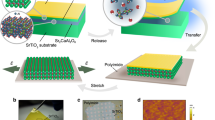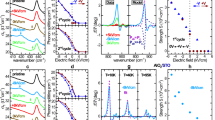Abstract
Local perturbations in complex oxides, such as domain walls1,2, strain3,4 and defects5,6, are of interest because they can modify the conduction or the dielectric and magnetic response, and can even promote phase transitions. Here, we show that the interaction between different types of local perturbations in oxide thin films is an additional source of functionality. Taking SrMnO3 as a model system, we use nonlinear optics to verify the theoretical prediction that strain induces a polar phase, and apply density functional theory to show that strain simultaneously increases the concentration of oxygen vacancies. These vacancies couple to the polar domain walls, where they establish an electrostatic barrier to electron migration. The result is a state with locally structured room-temperature conductivity consisting of conducting nanosized polar domains encased by insulating domain boundaries, which we resolve using scanning probe microscopy. Our ‘nanocapacitor’ domains can be individually charged, suggesting stable capacitance nanobits with a potential for information storage technology.
This is a preview of subscription content, access via your institution
Access options
Subscribe to this journal
Receive 12 print issues and online access
$259.00 per year
only $21.58 per issue
Buy this article
- Purchase on Springer Link
- Instant access to full article PDF
Prices may be subject to local taxes which are calculated during checkout





Similar content being viewed by others
References
Salje, E. K. H. & Zhang, H. L. Domain boundary engineering. Phase Trans. 82, 452–469 (2009).
Catalan, G., Seidel, J., Ramesh, R. & Scott, J. F. Domain wall nanoelectronics. Rev. Mod. Phys. 84, 119–156 (2012).
Schlom, D. G. et al. Strain tuning of ferroelectric thin films. Annu. Rev. Mater. Res. 37, 589–626 (2007).
Lee, J. H. et al. A strong ferroelectric ferromagnet created by means of spin-lattice coupling. Nature 466, 954–958 (2010).
Kalinin, S. V., Johnson, C. Y. & Bonnel, D. A. Domain polarity and temperature induced potential inversion on the BaTiO3 (100) surface. J. Appl. Phys. 91, 3816–3823 (2002).
Aschauer, U., Pfenninger, R., Selbach, S. M., Grande, T. & Spaldin, N. A. Strain-controlled oxygen vacancy formation and ordering in CaMnO3 . Phys. Rev. B 88, 054111 (2013).
Bhattacharjee, S., Bousquet, E. & Ghosez, P. Engineering multiferroism in CaMnO3 . Phys. Rev. Lett. 102, 117602 (2009).
Lee, J. H. & Rabe, M. K. Epitaxial-strain-induced multiferroicity in SrMnO3 from first principles. Phys. Rev. Lett. 104, 207204 (2010).
Rondinelli, J. M., Eidelson, A. S. & Spaldin, N. A. Non-d0 Mn-driven ferroelectricity in antiferromagnetic BaMnO3 . Phys. Rev. B 79, 205119 (2009).
Sakai, H. et al. Displacement-type ferroelectricity with off center magnetic ions in perovskite Sr1–xBaxMnO3 . Phys. Rev. Lett. 107, 137601 (2011).
Kobayashi, S. et al. Labyrinth-type domain structure of heteroepitaxial SrMnO2.5 film. Appl. Phys. Lett. 102, 231911 (2013).
Giovannetti, G., Kumar, S., Ortix, C., Capone, M. & van den Brink, J. Microscopic origin of large negative magnetoelectric coupling in Sr1/2Ba1/2MnO3 . Phys. Rev. Lett. 109, 107601 (2012).
Fiebig, M., Fröhlich, D., Lottermoser, Th. & Maat, M. Probing of ferroelectric surface and bulk domains in ferroelectric RMnO3 (R=Y, Ho) by second harmonic generation. Phys. Rev. B 66, 144102 (2002).
Johann, F., Hoffmann, Á. & Soergel, E. Impact of electrostatic forces in contact-mode scanning force microscopy. Phys. Rev. B 81, 094109 (2010).
Rørmark, L., Wiik, K., Stølen, S. & Grande, T. Oxygen stoichiometry and structural properties of La(1–x)AxMnO3+− δ (A= Ca or Sr and 0 ≤ x ≤ 1). J. Mater. Chem. 12, 1058–1067 (2002).
Scheiber, P. et al. (Sub)surface mobility of oxygen vacancies at the TiO2 anatase (101) surface. Phys. Rev. Lett. 109, 136103 (2012).
Damjanovic, D. Ferroelectric, dielectric and piezoelectric properties of ferroelectric thin films and ceramics. Rep. Prog. Phys. 61, 1267–1324 (1998).
Chmaissem, O. et al. Relationship between structural parameters and the Néel temperature in Sr1–xCaxMnO3 (0 ≤ x ≤ 1) and Sr1–yBayMnO3 (y ≤ 0.2). Phys. Rev. B 64, 134412 (2001).
Kobayashi, S. et al. Cation off-stoichiometric SrMnO3-δ thin film grown by pulsed laser deposition. J. Mater. Sci. 46, 4354–4360 (2011).
Fiebig, M., Pavlov, V. & Pisarev, R. Second-harmonic generation as a tool for studying electronic and magnetic structures of crystals. J. Opt. Soc. Am. B 22, 96–118 (2005).
Kresse, G. & Furthmuller, J. Efficient iterative schemes for ab initio total-energy calculations using a plane-wave basis set. Phys. Rev. B 54, 11169–11186 (1996).
Dudarev, S. L., Botton, G. A., Savrasov, S. Y., Humphreys, C. J. & Sutton, A. P. Electron-energy-loss spectra and the structural stability of nickel oxide: an LSDA + U study. Phys. Rev. B 57, 1505–1509 (1998).
Hong, J., Stroppa, A., Íñiguez, J., Picozzi, S. & Vanderbilt, D. Spin-phonon coupling effects in transition-metal perovskites: A DFT + U and hybrid-functional study. Phys. Rev. B 85, 054417 (2012).
Blöchl, P. E. Projector augmented-wave method. Phys. Rev. B 50, 17953–17979 (1994).
Kresse, G. & Joubert, D. From ultrasoft pseudopotentials to the projector augmented-wave method. Phys. Rev. B 59, 1758–1775 (1999).
Lee, J. H. & Rabe, M. K. Epitaxial-strain-induced multiferroicity in SrMnO3 from first principles. Phys. Rev. Lett. 104, 207204 (2010).
Aschauer, U., Pfenninger, R., Selbach, S. M., Grande, T. & Spaldin, N. A. Strain-controlled oxygen vacancy formation and ordering in CaMnO3 . Phys. Rev. B 88, 054111 (2013).
Acknowledgements
The authors thank Helmholtz-Zentrum Berlin for the allocation of synchrotron radiation beamtime and C.M. Schneider for support, as well as A. Weber of the Paul Scherrer Institute for providing reference samples for the EFM measurements. The authors thank J. Rupp and M. Kubicek for advice on the oxygen vacancy dynamics in oxide films. M.F., D.M. and M.L. acknowledge funding from grant ‘ETH-06 12-2’ and from SNF proposal no. 200021-149192. The authors acknowledge funding through the SNF R’equip Program (no. 206021-144988). M.T and C.B. thank the ETH FIRST lab for granting access to the XRD characterization platform. Financial support from Spanish Ministerio de Economía y Competitividad through projects MAT2011-27553-C02, MAT2012-38213-C02-01, MAT2014-51982-C2 and from Regional Gobierno de Aragón through project E26 is acknowledged. The TEM, XPS and XRD work was conducted in the Laboratorio de Microscopías Avanzadas at the Instituto de Nanociencia de Aragón – Universidad de Zaragoza, which the authors acknowledge for offering access to instruments and expertise.
Author information
Authors and Affiliations
Contributions
C.B. performed and analysed the SHG measurements. L.M. grew the samples and characterized them, together with C.M., J.B., E.L. and M.T., by XRD and STEM. M.L. and C.B. performed EFM. D.M. and I.P.K. carried out LEEM. U.A. performed the DFT calculations. P.A.A., J.A.P., N.A.S. and M.F. supervised the project.
Corresponding author
Ethics declarations
Competing interests
The authors declare no competing financial interests.
Supplementary information
Supplementary information
Supplementary information (PDF 1625 kb)
Rights and permissions
About this article
Cite this article
Becher, C., Maurel, L., Aschauer, U. et al. Strain-induced coupling of electrical polarization and structural defects in SrMnO3 films. Nature Nanotech 10, 661–665 (2015). https://doi.org/10.1038/nnano.2015.108
Received:
Accepted:
Published:
Issue Date:
DOI: https://doi.org/10.1038/nnano.2015.108
This article is cited by
-
Tunable ferroelectricity in oxygen-deficient perovskites with Grenier structure
npj Computational Materials (2023)
-
Guided anisotropic oxygen transport in vacancy ordered oxides
Nature Communications (2023)
-
Oxygen vacancies in nanostructured hetero-interfacial oxides: a review
Journal of Nanoparticle Research (2022)
-
Tunable spin-valley coupling in layered polar Dirac metals
Communications Materials (2021)
-
Ferroelectric domain walls for nanotechnology
Nature Reviews Materials (2021)



